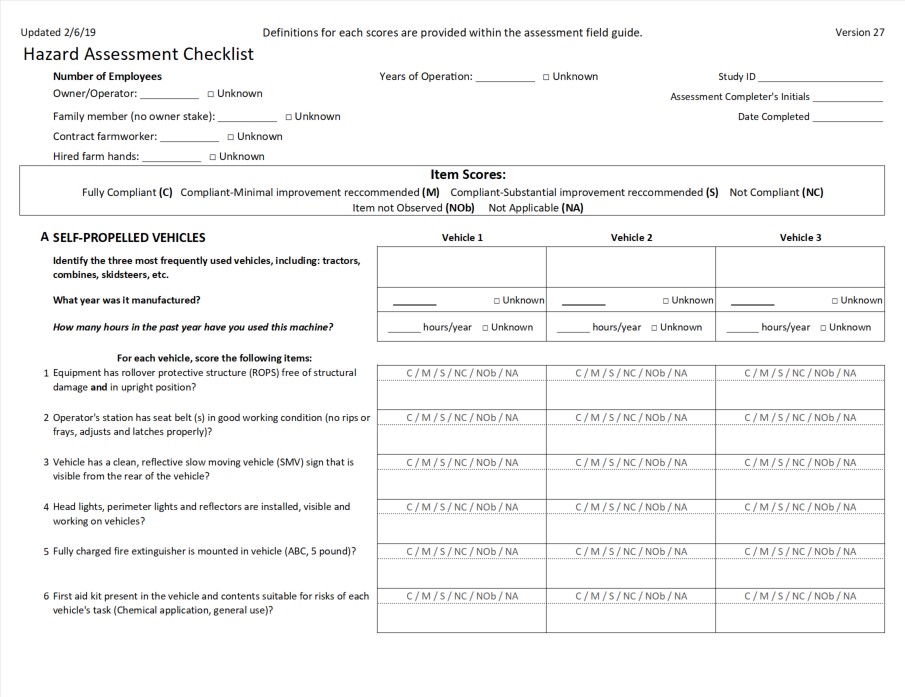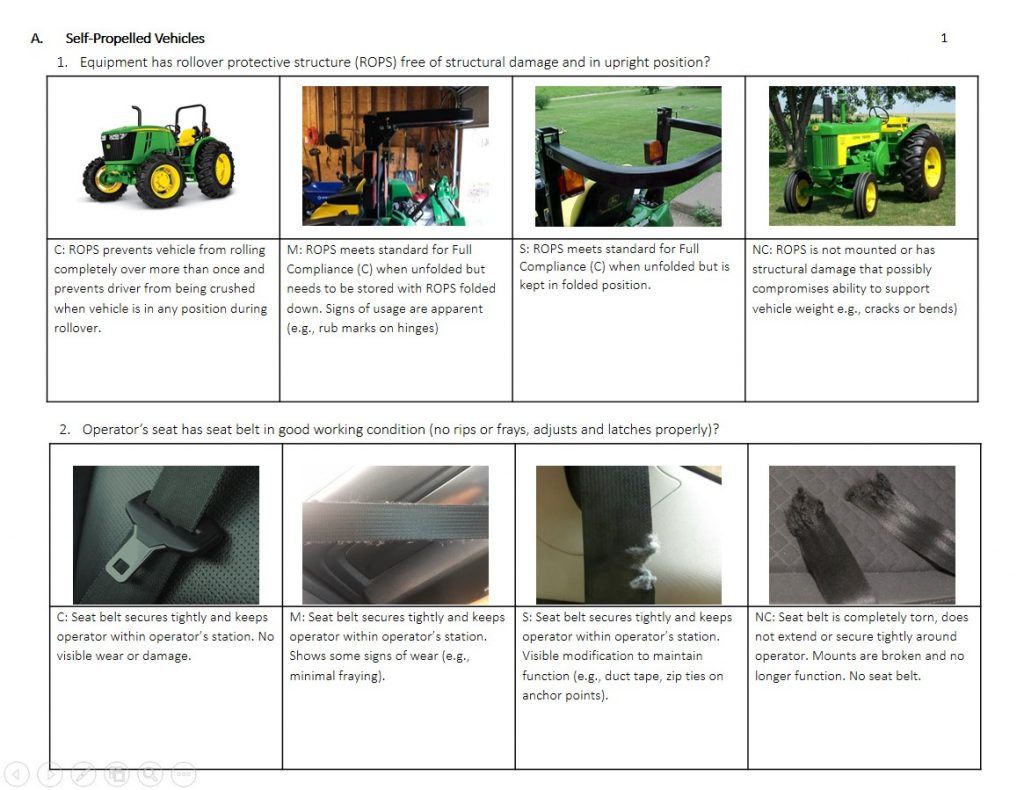
In a new analysis of Iowa agricultural injuries during a four year period, we found that only 20% of cases had worker’s compensation identified as the primary payer.
“This project involves in-depth analysis of multiple methods and data sources for accurately capturing both agricultural injuries and risk factors.” – Marizen Ramirez PhD
Recent updates
- Round one of training for the Farm Safety Hazard App was conducted July 14, 2021. A second round of training took place in November during MRASH 2021. Farm Safety Hazard App
Recent papers
Baidwan NK, Ramirez MR, Gerr F, Boonstra D, Cavanaugh JE, Casteel C. Cost, Severity and Prevalence of Agricultural-Related Injury Workers’ Compensation Claims in Farming Operations from 14 U.S. States. International Journal of Environmental Research and Public Health. 2021; 18(8):4309. Formatted paper
Faust K, Casteel C, McGehee D, Peek-Asa C, Rohlman D, Ramirez MR. Examining the association between age and tractor driving performance measures using a fidelity tractor driving simulator. Journal of Agricultural Safety and Health. 2021: 27(3):159-175. Public Access
Why is this research important?
Although it is well-established that agriculture is among the most dangerous industries and occupations worldwide, surveillance of agricultural injuries and their risk factors – a key strategy for prevention – is poorly conducted and wrought with methodologic challenges. To address this significant gap, we are conducting two surveillance projects to 1) analyze agricultural injuries captured in three unique administrative datasets from a state labor agency, hospitals, and an insurance company, and 2) develop and pilot test a hazard assessment tool to conduct surveillance of agricultural injury hazards.
The aims of this research are to:
- Estimate the incidence of agricultural injury in Iowa reported through three sources: the Iowa Trauma Registry, the statewide Workers’ Compensation data, and one insurance company’s Worker’s Compensation program; and
- Compare agricultural injuries by severity, type, mechanism and demographics reported by farm operations in workers’ compensation claims with those reported in the Iowa Trauma Registry.
- Develop and test the effectiveness of a hazard assessment checklist tool in identifying hazards associated with increased risk of agricultural injury.
Who’s on the research team?
Research Assistants
What have we learned?
Study 1
Nationwide Insurance Company Workers’ Compensation (WC) Data: A total of 1,059 claims from 662 agricultural policy holders from 21 states (AR, AZ, GA, IA, IN, KS, MD, MI, MN, MO, MS, NE, NH, NY, PA, SC, SD, TN, TX, VA, and WI) were obtained for the years 2010-2016. Over the nine-year period, the most frequent claim type was medical claims (66.4% of all claims filed), followed by temporary disability (21.7%), permanent disability (11.2%), and death (0.7%). Of these, 917 claims were paid by the WC program, of which 65% were medical only claims. While the median costs of claims were highest for death ($197,538) and permanent disability ($47,777), the most costly over the nine-year period were permanent disability claims ($16 million) followed by temporary disability claims ($3.6 million). The risk of having a death/disability claim as opposed to a medical claim was over two-fold higher when strains were the cause compared to all other causes and over one-fold higher when the object-handling was the event compared to all other events.
Iowa Trauma Registry: Trauma cases were defined as having at least one injury (ICD-9-CM diagnosis code between 800.0 and 959.9) leading to an admission, death upon arrival or after hospital treatment/evaluation, transfers into/out of the facility, or trauma activations. We focused on farmwork-related trauma cases, which were designated by the treating hospital. A total of 2,543 farm work-related cases were captured from 2005-2014, with age ranging from 10 to 105 years old and the majority being male (92.5%). The main causes of injury were from machinery (26.8%), falls (17.8%), struck by/against (12.4%), and natural/environmental (10.2%–mostly involving injuries caused by an animal). Two-thirds of the injuries had an injury severity score (ISS) of 1-8 (mild), followed by 20% with an ISS of 9-15 (moderate), and 12% with an ISS of 16 or greater (severe).
Iowa Department of Labor Data: We have also accessed agricultural-related WC claims submitted to the Iowa Division of Workers’ Compensation from 2005 to 2014. These cases were identified using Standard Industrial Classification (SIC) codes. Of the 3,771 claims submitted, age ranged from 12 to 95 and males accounted for 82.4% of the workers that reported a claim. The main causes of injury were due to strains/injury by (26.3%–e.g., twisting, holding/carrying, lifting, reaching), slip/trip/falls (24.5%), and struck/injured by (17.4%–e.g., falling/flying object, hand tool/machine in use, moving parts of machine, object being lifted/handled).
A total of 3.7% of WC records have successfully linked with the Iowa Trauma Registry, based on age, gender, residence zip code and date of injury. We are beginning to conduct analysis on linked and unlinked data.
Study 2
Hazard Assessment Checklist
With guidance from our multidisciplinary GPCAH internal and external advisory committee members, the team developed an agricultural hazard assessment checklist (above) to collect data on exposures associated with traumatic injury. The tool includes questions about the features of buildings and equipment on the farm. An assessment of equipment/buildings will be conducted for specific safety characteristics determined by industry standards and expert input, and a score will be provided by the observers. Observers have been trained to complete the checklist during a visit to the farm. A companion field guide was generated using questions from the hazard assessment tool, industry standards, and sample photographs to demonstrate how to fill out the hazard assessment tool (page 1 provided below). The tool and field guide were pilot tested at five Iowa farms, and updates to the tool were implemented.
Hazard Assessment Checklist Field Guide
What’s next?
Study 1
We will conduct and continue analysis of the 1) Nationwide Insurance data, 2) linked State WC and State Trauma Registry data, and 3) unlinked state data. We anticipate developing abstracts for presentation and drafts of manuscripts.
Study 2
We will begin recruitment and data collection at 75 farm operations. We will be working with the Iowa Social Science Research Center to recruit farmers and schedule site visits to conduct our hazard assessments.
One-pager from 2016-22 GPCAH Evaluation Report
See brief one-page summary of the project’s impact here.
Page last updated 01/13/2025







